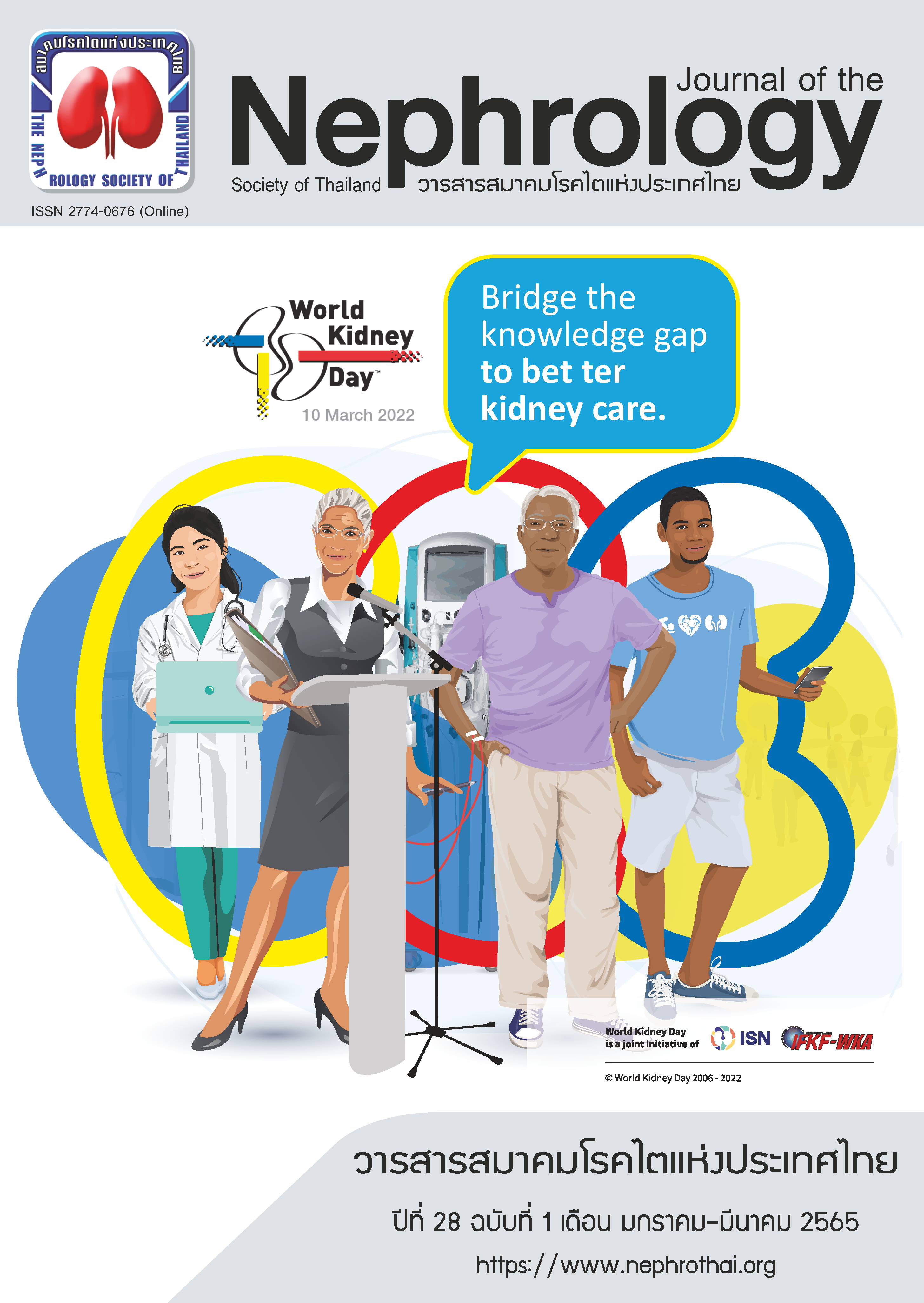Analgesic nephropathy
Main Article Content
Abstract
Analgesic nephropathy is a chronic kidney disease leading to end stage renal disease that can be prevented or often arrest renal progression. The term usually refers to kidney injury induced by excessive and long use of analgesics or analgesic mixtures, especially combinations including phenacetin. The incidence of disease is uncertain because a definite diagnostic criterion is rarely made. Renal pathologic findings are characterized by renal papillary necrosis and chronic interstitial nephritis. This condition is common found among middle-aged women in around 50 to 80% of females. Commonly used drugs associated with analgesic nephropathy include aspirin, salicylamide and acetaminophen. The main mechanisms of kidney injury are accumulation of N-acetyl-p-benzoquinoneimine, the reactive metabolite of acetaminophen producing lipid peroxides and arylation of tissue proteins and renal medullary ischemia. Clinical manifestations of analgesic nephropathy are generally nonspecific. It constitutes a slowly progressive form of kidney injury with and without sterile pyuria. Some patients develop renal colic from necrotic renal papillae with obstructive uropathy. Diagnostic criteria have been defined based on history of analgesic consumption and renal computed tomography scanning without contrast. The observation of decreased renal mass, combined with either bumpy contour or papillary calcification showed a high sensitivity and specificity for diagnosing disease. The first line of treatment is to discontinue the offending drug to prevent any further damage without specific treatment. The clinical course varies and depends mainly on the extent of renal damage. In addition to renal impairment, prolonged heavy analgesic use can lead to atherosclerotic disease and urothelial carcinoma.
Article Details

This work is licensed under a Creative Commons Attribution-NonCommercial-NoDerivatives 4.0 International License.
This article is published under CC BY-NC-ND 4.0 license, which allows for non-commercial reuse of the published paper as long as the published paper is fully attributed. Anyone can share (copy and redistribute) the material in any medium or format without having to ask permission from the author or the Nephrology Society of Thailand.
References
Henrich WL, Agodoa LE, Barrett B, Bennett WM, Blantz RC, Buckalew VM, Jr., et al. Analgesics and the kidney: summary and recommendations to the Scientific Advisory Board of the National Kidney Foundation from an Ad Hoc Committee of the National Kidney Foundation. Am J Kidney Dis. 1996;27:162-5.
Sampathkumar K, Rajiv A, Sampathkumar D. Analgesic Nephropathy–-A Painful Progression. Clinical Medicine Insights: Urology. 2016;9: S13179.
De Broe ME, Elseviers MM. Analgesic Nephropathy. N Engl J Med. 1998; 338(7):446-52.
Fenton S, Desmeules M, Copleston P, Arbus G, Froment D, Jeffery J, et al. Renal replacement therapy in Canada: a report from the Canadian Organ Replacement Register. Am J Kidney Dis. 1995;25:134-50.
Gault MH, Wilson DR. Analgesic nephropathy in Canada: clinical syndrome, management, and outcome. Kidney Int. 1978;13:58-63.
Yaxley J. Common Analgesic Agents and Their Roles in Analgesic Nephropathy: A Commentary on the Evidence. Korean J Fam Med. 2016;37:310-6.
Vadivel N, Trikudanathan S, Singh AK. Analgesic nephropathy. Kidney Int. 2007;72:517-20.
Schlondorff D. Renal prostaglandin synthesis. Sites of production and specific actions of prostaglandins. Am J Med. 1986;81:1-11.
Sandler DP, Smith JC, Weinberg CR, Buckalew VM, Jr., Dennis VW, Blythe WB, et al. Analgesic use and chronic renal disease. N Engl J Med. 1989;320:1238-43.
Fored CM, Ejerblad E, Lindblad P, Fryzek JP, Dickman PW, Signorello LB, et al. Acetaminophen, aspirin, and chronic renal failure. N Engl J Med. 2001;345:1801-8.
Curhan GC, Knight EL, Rosner B, Hankinson SE, Stampfer MJ. Lifetime nonnarcotic analgesic use and decline in renal function in women. Arch Intern Med. 2004;164:1519-24.
Kanchanasurakit S, Arsu A, Siriplabpla W, Duangjai A, Saokaew S. Acetaminophen use and risk of renal impairment: A systematic review and meta-analysis. Kidney Res Clin Pract. 2020;39:81-92.
Perneger TV, Whelton PK, Klag MJ. Risk of Kidney Failure Associated with the Use of ฟacetaminophen, Aspirin, and Nonsteroidal Antiinflammatory Drugs. N Engl J Med.1994;331:1675-9.
Morlans M, Laporte JR, Vidal X, Cabeza D, Stolley PD. End-stage renal disease and non-narcotic analgesics: a case-control study. Br J Clin Pharmacol. 1990;30:717-23.
Fored CM, Ejerblad E, Lindblad P, Fryzek JP, Dickman PW, Signorello LB, et al. Acetaminophen, Aspirin, and Chronic Renal Failure. N Engl J Med. 2001;345:1801-8.
Duggin GG. Combination analgesic-induced kidney disease: the Australian experience. Am J Kidney Dis. 1996;28:S39-47
Bach PH, Hardy TL. Relevance of animal models to analgesic-associated renal papillary necrosis in humans. Kidney Int. 1985;28:605-13.
Murray TG, Goldberg M. Analgesic-associated nephropathy in the U.S.A.: epidemiologic, clinical and pathogenetic features. Kidney Int 1978;13:64-71.
Pereira BJ, de Andrade R. Renal papillary necrosis in a patient with sickle cell disease. Rev Bras Hematol Hemoter. 2016;38:267-70.
Jung DC, Kim SH, Jung SI, Hwang SI, Kim SH. Renal Papillary Necrosis: Review and Comparison of Findings at Multi–Detector Row CT and Intravenous Urography. RadioGraphics 2006;26:1827-36.
Dubach UC, Rosner B, Stürmer T. An Epidemiologic Study of Abuse of Analgesic Drugs. N Engl J Med.1991;324:155-60.
McCredie M, Stewart JH, Carter JJ, Turner J, Mahony JF. Phenacetin and papillary necrosis: independent risk factors for renal pelvic cancer. Kidney Int.1986;30:81-4.
Nanra RS. Renal effects of antipyretic analgesics. Am J Med. 1983;75:70-81.
Blohmé I, Johansson S. Renal pelvic neoplasms and atypical urothelium in patients with end-stage analgesic nephropathy. Kidney Int. 1981;20:671-5.
Mackinnon B, Boulton-Jones M, McLaughlin K. Analgesic-associated nephropathy in the West of Scotland: a 12-year observational study. Nephrol Dial Transplant. 2003;18:1800-5.


